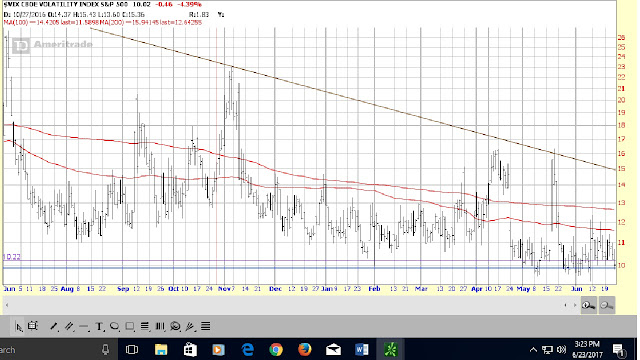The Morning Call
6/27/17
It is summertime and this year
the living isn’t particularly easy in Texas.
It is way too hot. So I am
departing for cooler climates tomorrow and won’t be back to mid-July (yes, I know,
it will still be hot). As always I will
have my computer with me and if action is needed, I will communicate via
Subscriber Alerts. Though I will note,
that given the extent of equity overvaluation, it will take a hell of a selloff
to prompt any action.
The
Market
Technical
The indices
(DJIA 21409, S&P 2439) rose fractionally on low volume but slightly
improved breadth. They retain their
upward momentum as defined by their 100 and 200 day moving averages and
uptrends across all timeframes. At the
moment, I see nothing, technically speaking, to inhibit the Averages’ challenge
of the upper boundaries of their long term uptrends---now circa
24198/2763.
The VIX (9.9) fell
another 1 ¼ %, ending below the lower boundary of its intermediate term trading
range for the second day (if it remains there though the close on Wednesday, it
will reset to a downtrend) and right on the lower boundary of its long term
trading range. Remember that it has unsuccessfully
attempted to reset both of these boundaries six times since mid-April. Odds suggests a seventh failure.
The long
Treasury remains in a solid uptrend, finishing above its 100 and 200 day moving
averages (now support), in very short term and long term uptrends and in a
short term trading range---continuing to reflect bond investors’ doubts about a
strong economy/rising inflation.
The dollar rose
slightly ($0.04), ending in a very short term downtrend and below its 100 and
200 day moving averages---also lending little support to the strong
economy/rising inflation scenario.
GLD declined,
closing below the upper boundary of its short term trading range, back below
its 100 day moving average, voiding Friday’s break but above its 200 day moving
average.
Bottom line: the
Averages meandered through another lazy, low volume summer day, ostensively
impervious to the data flow. That
suggests that there are few concerns and, in general, everyone is happy with
what they own. I have no insight into
how long this lethargy will last; but it seems reasonable to assume that,
technically speaking, the indices next big move will be to challenge the upper
boundaries of their long term uptrends.
Yesterday
in charts (short):
Fundamental
Headlines
The
economic data got off to a very rough start this week: May durable goods, the
May Chicago Fed national activity index and the June Dallas Fed manufacturing
index were all disappointing---not the kind of follow through you want from
last week’s improved stats.
Overseas, the
Italian government bailed out two failed banks---a plan that did not meet EU
guidelines and called for the Italian taxpayers to put up $17 billion. Why is it that the taxpayers are always the
one getting screwed?
***overnight,
the Bank of England raised capital requirements on its banks.
Plus, Draghi made some
hawkish statements; and Yellen speaks today in London.
In
the US, the CBO released its much anticipated scoring of the senate version of
healthcare reform. The major items
include (1) 22 million will lose healthcare coverage by 2026 [23 million in the
house version], (2) it will reduce the deficit by $321 billion over the next
ten years [$119 billion in the house version] and (3) insurance premiums will
increase in the first two years, then decline in the third year. So it is better than the house version but
not a perfect bill. I would expect
further improvement in the final senate version and still more when, as and if
it reaches reconciliation. Who knows
what the final product will look like; but some progress is better than no
progress. So I think it too soon for the
gnashing of teeth and tearing of hair.
Bottom line: the
numbers are not improving; and the Fed appears determined in its drive to
tighten monetary policy. As you know, I am
not concerned about the economic consequences of the latter but believe that it
will impact equity valuations. As a
result, I believe that every investor should have some cash reserves. It is impossible to buy low if you don’t sell
high.
The
latest Fed statements (medium):
The
nightmare scenario (medium):
Investing for Survival
The
hardest thing.
News on Stocks in Our Portfolios
Boeing
(NYSE:BA) declares $1.42/share quarterly dividend,
in line with previous.
Revenue of $312.1M (+8.6% Y/Y) in-line.
Economics
This Week’s Data
The
June Dallas Fed’s manufacturing index came in at 15.0 versus expectations of
18.0.
Other
Another
lesson from Japan (medium):
This
is what a bubble looks like (medium):
GM
raising $3 billion to fund pension plan (short):
Update
on credit markets (medium):
Politics
Domestic
Supreme Court re-instates
temporary travel ban, sort of (short):
International War Against Radical
Islam
Visit Investing
for Survival’s website (http://investingforsurvival.com/home)
to learn more about our Investment Strategy, Prices Disciplines and Subscriber
Service.





